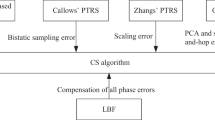Abstract
The raw echoed signal considered to be an input of signal processors of multireceiver synthetic aperture sonar (SAS) system plays an important role in multireceiver SAS imaging algorithms and system design. Traditional echo simulation methods such as time-domain algorithm are characterized by time-consuming. To improve the simulation efficiency of SAS echoed signal, this paper proposes a novel method to simulate the SAS raw echo. The presented method firstly calculates the time delay corresponding to each target. Based on the spectrum of transmitted signal in the Fourier domain, the spectrum of echoed signal can be accurately obtained by the complex multiplication between the spectrum of transmitted signal and the phase shifting related to the time delay. This operation is repeatedly conducted for each target, and the final echo can be obtained by the inverse Fourier transformation. Compared to traditional echo simulation algorithms, the presented method can significantly improve the simulation efficiency of echoed signal without loss of performance. At last, the simulations well demonstrate that the presented method is highly efficient compared to traditional methods.












Similar content being viewed by others
Data availability
The datasets generated and analyzed during the current study are available from the corresponding author on reasonable request.
References
Kerstens R, Laurijssen D, Steckel J (2019) An optimized planar MIMO array approach to in-air synthetic aperture sonar. IEEE Sens Lett 3:1–4
Zhang X, Ying W (2022) Influence of the element beam pattern on synthetic aperture sonar imaging. Geomatics Inf Sci Wuhan Univ 47:133–140
Huang P, Yang P (2022) Synthetic aperture imagery for high-resolution imaging sonar. Front Mar Sci 9:1049761
Zhang X, Yang P, Sun H (2023) An omega-k algorithm for multireceiver synthetic aperture sonar. Electron Lett 59:1–3
Dillon J, Charron R (2019) Resolution measurement for synthetic aperture sonar. 2019 MTS/IEEE Oceans Conference, Seattle, WA, USA, pp 1–6
Wang M, Huang P (2023) A multireceiver SAS imaging algorithm and optimization. IEEE Access 11:75112–75120
Zhang X, Yang P, Zhou M (2023) Multireceiver SAS imagery with generalized PCA. IEEE Geosci Remote Sens Lett 20:1502205
Hall JJ, Azimi-Sadjadi MR, Kargl SG, Zhao Y, Williams KL (2019) Underwater unexploded ordnance (UXO) classification using a matched subspace classifier with adaptive dictionaries. IEEE J Oceanic Eng 44:739–752
Brandes TS, Ballard B (2019) Adaptive seabed characterization with hierarchical Bayesian modeling of SAS imagery. IEEE Trans Geosci Remote Sens 57:1278–1290
Köhntopp D, Lehmann B, Kraus D, Birk A (2019) Classification and localization of naval mines with superellipse active contours. IEEE J Oceanic Eng 44:767–782
Xue A, Mao K, Zhang L (2023) Multi-feature marine small target detection based on multi-class classifier. J Electron Inf Technol 45:2528–2536
Huang P, Teng X, Zhong H (2022) Adaptive filtering method combined with quality map for InSAS interferogram. Electron Lett 58:1009–1022
Hunter A (2006) Underwater acoustic modeling for synthetic aperture sonar. University of Canterbury, Christchurch
Kim SW, Lee YK (2022) Accurate water level measurement in the bridge using X-band SAR. IEEE Geosci Remote Sens Lett 19:1503305
Chen M, Zhang S, Tang J (2009) An interferometric synthetic aperture sonar raw signal simulation based on points-scatterer model. 2009 International Joint Conference on Computational Sciences and Optimization. Sanya, China, pp 367–370
Sun H, Zhang X, Tian F, Xing J, Miao Y, Ying W (2023) Advanced technology and application of underwater acoustic detection. Posts & Telecom Press, Beijing
Huang P, Zhong H (2021) A raw echo simulation method based on reference signal translation for InSAS. 2021 14th International Congress on Image and Signal Processing, BioMedical Engineering and Informatics (CISP-BMEI). Shanghai, China, pp 1–5
Huang P, Huang J, Yue J, Zhong H, Zhang S (2017) A fast simulation method of raw echo for interferometric synthetic aperture sonar. J Nav Univ Eng 29:25–28
Yang J, Ma M, Zhong H (2019) A fast echo simulation method for synthetic aperture sonar based on Matlab. Ship Electron Eng 39:187–190
Kaur S, Chaudhary G, Kumar JD et al (2022) Optimizing fast Fourier transform (FFT) image compression using intelligent water drop (IWD) algorithm. Int J Interact Multimedia Artif Intell 7:48–55
Sahu LP, Pradhan G, Singh JP (2022) Modeling sub-band information through discrete wavelet transform to improve intelligibility assessment of dysarthric speech. Int J Interact Multimed Artif Intell 7:56–64
Li Y, Deng J, Wu Q, Wang Y (2021) Eye-tracking signals based affective classification employing deep gradient convolutional neural networks. Int J Interact Multimed Artif Intell 7:34–43
Yang P, Liu J (2022) Effect of non-unifrom sampling on sonar focusing. 2022 14th International Conference on Communication Software and Networks. Chongqing, China, pp 109–113
Cumming I, Wong F (2005) Digtal processing of synthetic aperture radar data: algorithms and implementation. Norwood, MA, USA, Artech House
Huang P, Tang J, Zhong H, Xu K (2019) A new InSAS regestration method based on rational function surface fitting. Geomatics Inf Sci Wuhan Univ 44:601–607
Funding
The author(s) disclosed receipt of the following financial support for the research, authorship, and/or publication of this article: The work described in this article was partially supported by the National Key Laboratory Foundation under Grant 9140C290401150C29132.
Author information
Authors and Affiliations
Corresponding author
Ethics declarations
Conflict of interests
The author(s) declared no potential conflicts of interest with respect to the research, authorship, and/or publication of this article.
Additional information
Publisher's Note
Springer Nature remains neutral with regard to jurisdictional claims in published maps and institutional affiliations.
Rights and permissions
Springer Nature or its licensor (e.g. a society or other partner) holds exclusive rights to this article under a publishing agreement with the author(s) or other rightsholder(s); author self-archiving of the accepted manuscript version of this article is solely governed by the terms of such publishing agreement and applicable law.
About this article
Cite this article
Zhang, X. An efficient method for the simulation of multireceiver SAS raw signal. Multimed Tools Appl 83, 37351–37368 (2024). https://doi.org/10.1007/s11042-023-16992-5
Received:
Revised:
Accepted:
Published:
Issue Date:
DOI: https://doi.org/10.1007/s11042-023-16992-5




